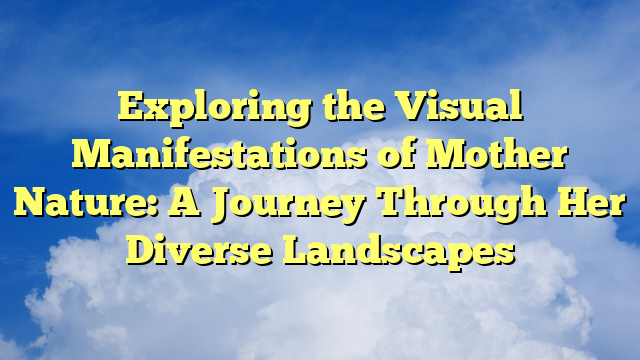Exploring the Visual Manifestations of Mother Nature: A Journey Through Her Diverse Landscapes
Exploring the Visual Manifestations of Mother Nature: A Journey Through Her Diverse Landscapes
Mother Nature has an unparalleled way of expressing herself through the diverse landscapes that adorn our planet. From the towering peaks of mountains to the vast expanses of deserts, each landscape presents a unique visual manifestation of Earth’s natural beauty. This journey through her diverse landscapes not only offers a feast for the eyes but also provides a deeper understanding of the environment we inhabit.
The Majestic Mountains
Mountains stand as sentinels of the Earth, their peaks reaching towards the skies. They are not just physical entities but symbols of awe and inspiration. Let’s delve into the different types of mountains and their significance.
Types of Mountains
- Fold Mountains: Formed by the folding of the Earth’s crust, these are some of the most common and extensive mountain ranges, like the Himalayas.
- Volcanic Mountains: Born from volcanic activity, these mountains, such as Mount Fuji in Japan, remind us of the Earth’s fiery core.
- Block Mountains: Created by the shifting and cracking of the Earth’s crust, resulting in blocks of land being pushed up, like the Sierra Nevada.
Significance of Mountains
Mountains are crucial for biodiversity, acting as habitats for numerous species. They also play a vital role in water cycles, trapping moisture from the atmosphere and providing fresh water to rivers and lakes below.
The Vast Deserts
Deserts, often perceived as lifeless expanses, are brimming with life and beauty. Their vastness and the survival of flora and fauna within them are testaments to nature’s resilience.
Characteristics of Deserts
- Low Precipitation: Deserts receive less than 250mm of rain per year, defining their arid nature.
- Extreme Temperatures: They can be scorchingly hot during the day and freezing at night, showcasing dramatic temperature shifts.
- Specialized Flora and Fauna: Species in deserts have adapted to survive with minimal water, like cacti and camels.
Desert Landscapes
Deserts are not monolithic; they vary greatly. The Sahara is known for its vast sand dunes, while the Atacama showcases salt flats and rock formations.
The Mystical Forests
Forests are the lungs of our planet, breathing life into the atmosphere and housing incredible biodiversity. They range from tropical rainforests to temperate deciduous forests, each with its unique ecosystem.
Importance of Forests
- Carbon Sequestration: Forests absorb carbon dioxide, mitigating the effects of climate change.
- Habitat for Species: They provide a home for over 80% of the world’s terrestrial biodiversity.
- Human Resources: Forests offer resources like wood, medicine, and food, besides being crucial for freshwater sources.
The Tranquil Lakes and Rivers
Water bodies are the essence of life. Lakes and rivers not only provide habitats for aquatic life but also serve as vital resources for human civilization.
Types of Lakes
| Type | Formation | Example |
|---|---|---|
| Glacial Lakes | Formed by glacial activity | Lake Louise, Canada |
| Tectonic Lakes | Formed by tectonic movements | Lake Baikal, Russia |
| Volcanic Lakes | Formed in volcanic craters | Crater Lake, USA |
Rivers: The Lifelines of Civilizations
Rivers have been cradles of human civilization, providing water for agriculture, transport, and as a source of freshwater. The Nile, Amazon, and Ganges are not just waterways but the heartbeats of the regions they flow through.
Conclusion
The visual manifestations of Mother Nature in her diverse landscapes are a testament to the beauty and resilience of our planet. From the towering mountains to the serene lakes, each landscape tells a story of evolution, survival, and the interconnectedness of life. As we explore these landscapes, we are reminded of our responsibility to protect and preserve them for future generations. The journey through Mother Nature’s diverse landscapes is not just a journey across space, but also a journey through time, witnessing the Earth’s past, present, and future.

